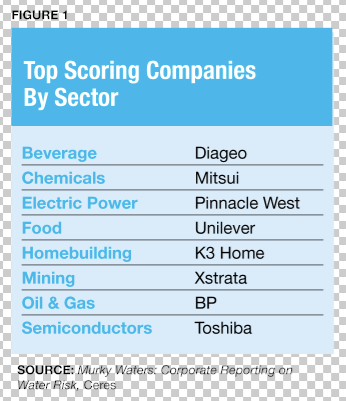Indeed, we often hear a lot about wastewater treatment, water management and water monitoring. But those are ineffective without accounting. Data and analytics facilitate accounting.

"Water utilities are still struggling with non-revenue water," Sarni says, talking about water lost to leaks or mismanagement.
Consumers also need efficiency tips-watering their lawns in the early morning hours, for example. You can waste as much as 30% of the water you use to evaporation by watering at midday. And regardless of what cooking instructions say, it takes only 1.5 quarts of water to cook a pound of pasta. (Most instructions require four to six quarts. In the U.S., we cook a billion pounds of pasta per year. That adds up to possible water savings equal to a billion gallons.)
Lost water can mean business opportunities, specifically in wireless technology-one of the great, unsung heroes of the sustainable water movement. Wireless monitors allow utilities to better track usage and spot leaks and inefficiencies, and several applications can shore up supplies. In certain municipalities, "meter readers" are housed inside vehicles. This means a utility representative can drive down streets collecting information without having to leave his or her vehicle, and data are then collected and analyzed immediately for aberrations. The information can be sent electronically to a customer alerting him of leakage. (Along with those conservation tips.)
Wireless technology also helps manage water usage inside the home. Small-screen displays can relay water use from meters on different outlets (the tap, the shower or an appliance), allowing users to better manage consumption.
There are also industrial needs for wireless water monitoring. In remote areas, pipelines can be equipped with signals that alert authorities when leaks occur. The company TaKaDu, for example, has developed software to target leaks in a water-supply network. Water loss, it notes, accounts for as much as 30% of the world's water production. The company's technology can identify leaks hundreds of miles away using sensors. It can also sometimes identify leaks before they happen by monitoring flow rates and anomalies.
Still, even if the world captured all the freshwater it's losing from leaks and mismanagement, that still wouldn't be enough to fill the gap in supply. We need to figure out ways to use our wastewater.
That's why membrane technology is all the rage. Membranes are essentially filters, and they're key to water reuse and recycling. But membrane technology is expensive. In China, it is still as much as three times more expensive than traditional treatment technologies (chemicals and less-high-tech filters). "As the need for high-quality water treatment increases, specifically for potable or high-quality industrial use or reuse, low-pressure membrane technology could develop a [big] market potential," posits the McKinsey & Co. report Charting Our Water Future. The thinking is that when costs come down, the market will be waiting.
Sarni says anything involving membrane technology in general has strong growth potential. But nanotechnology and low-energy treatment technology, especially for the shale gas industry, are particularly promising areas.
The trick to investing in any of these areas, of course, is finding the right opportunity and the best way in.
Tamin Pechet, chief executive of the Banyan Water company and chairman of Imagine H2O, a nonprofit, says the public investment landscape offers many ways to invest in the water industry, from utilities to exchange-traded funds to pooled funds to multinational corporations. However, he says there are few "pure plays."
For example, to gain exposure to up-and-coming water technology via investments in tech companies, people "have to do the digging themselves and go to conferences and network or use incubators such as Imagine H20." Those opportunities would be relegated to private equity investors. For publicly traded stock, Pechet says people could build their own ETFs-if they put in the time to screen companies and do the due diligence themselves.
What Pechet suggests would be a lot of work for the nonprofessional investor. Hence, financial advisors can play a critical role in vetting and creating a portfolio of water and water-related companies that facilitate water efficiency.








